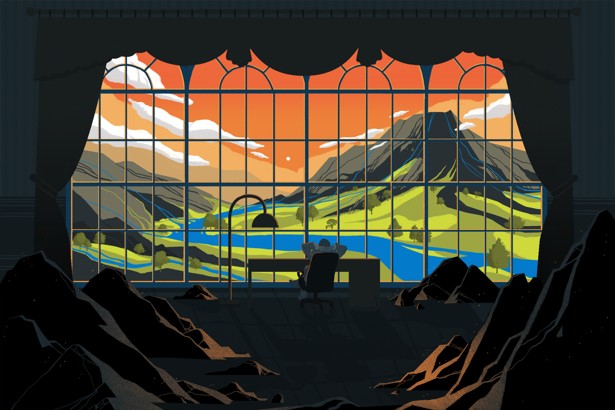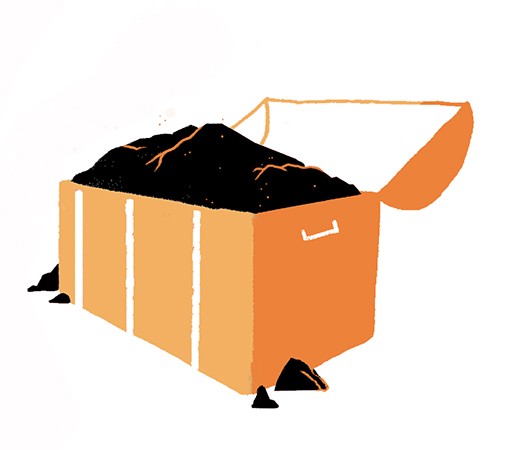
The idea is simple.
People burn fossil fuels. The fuels emit carbon dioxide into the atmosphere. If that carbon lingers in the air, it causes greenhousing and contributes to global warming; if it gets absorbed by the ocean, it acidifies the water and wrecks the marine food chain.
So the key is to put less carbon into the atmosphere. Most policies, accordingly, focus on preventing people from burning fuels. But what if the fossil fuels were never taken out of the ground in the first place?
In the most recent issue of The Atlantic, Bill Gates explains why he is devoting $2 billion toward an energy-research venture-capital fund. “The only reason I’m optimistic about [climate change] is because of innovation," he says. “If you told me that innovation had been frozen and we just have today’s technologies, will the world run the climate-change experiment? You bet we will.”
The only way to evade dangerous levels of global warming, he believes, is by finding and funding a low-emissions power source, then deploying it across the world at scale. By investing in technology, Gates argues that he can provide many times his money’s worth to humanity as a whole.
It’s a risky strategy. Gates’s teams may hit upon cold fusion or something like it, or his VC fund could fizzle out with little to show. If he really does believe that humanity is running out of time to meaningfully affect the climate system—and there, science agrees with him—he’s picked an awfully scattershot form of intervention.
What if he could attack the problem with more focus? It should be possible for someone with Gates’s wealth to stave off the worst of climate change, buying innovation more time to swoop in and save the day. But is there a way to intervene directly in the climate system—and not through sparkly, internationally dubious geo-engineering schemes like aerosols or sea fertilization, but through simple economics?
There might be. Enter Matt Frost.
I met Frost through Twitter. I knew him first as a witty, curious guy with an unusual collection of interests: mine safety, the statistics software R, the novelist Sigrid Undset, various forms of conservatism. I knew he has five kids, many dogs, and observes Orthodox Christianity. And I knew he had this plan for keeping coal in the ground.
As I talked to him for this story, and began to suss out the realism of what he calls his “coal retirement plan,” I learned that during the day, he works in natural-resource management. When you read the EPA’s reports on U.S. car-fuel efficiency and air pollution, you’re reading his work. So he knows what he’s talking about.

Anyway, here’s his plan.
Most climate regulations focus on making it more expensive to emit greenhouse gases. The cap-and-trade systems run by both the European Union and, soon, China take this approach: The thing they’re capping and trading is emissions.
Frost believes that instead of regulating to limit the burning of fossil fuels, we should just never remove the fuels from earth’s crust in the first place. Coal-fired power plants release about 40 percent of global carbon emissions and are a frequent target of climate policies. Frost thinks we should pay the organizations which own underground coal deposits—specifically, the U.S. government—for the right to never mine it.
“The U.S. coal deposits represent a potential store of future CO₂ emissions,” Frost told me. “The assumption, the policy assumption, is that they need to be extracted. But what if we just sequester this carbon while it’s still in coal form?”
By permanently keeping coal in the ground, carbon dioxide is, in turn, permanently kept out of the atmosphere. It will never trap heat in the atmosphere or debase the ocean. As such, buying unmined coal constitutes an incredibly cheap form of offsetting carbon consumption. But that’s not all it does: By sequestering coal from the global market, coal’s price rises. So coal retirement becomes a voluntary way of pricing in the mineral’s considerable climate, environmental, and public-health costs. Coal’s price could even rise internationally, weaning other nations off the fuel.
Buying coal while it’s still in the ground, in effect, constitutes a very inexpensive, very simple form of geoengineering. It’s perfect for climate-concerned billionaires like Gates.
There are two ways to go about it. They’re both somewhat feasible and a little complicated. Both also require a knowledge of U.S. land law.
The United States is one of very few nations in the world where mineral rights—the ability to mine an area—can be privately held. (In most nations, these rights are public or royal.) But U.S. rights differ depending on where you are. East of the Mississippi, a property owner typically controls not only the land that they have a deed to, but also the rights to mine any minerals beneath that land. In Appalachia, in particular, many property owners can and do sever those mineral rights from their surface rights and sell them to private companies. Rights get severed by coal seam, so it’s possible for multiple companies to own rights for one location, as long as they hold rights to different depths.
“If you ask someone to build a property map of mineral rights in West Virginia, you have to specify which coal seam, because each coal horizon can have a separate owner on the exact same lat-lon coordinates,” says Frost. “As you go up and down the mountain, you can run into different ownership.”
But west of the Mississippi, things work different. Especially in Montana and the Mountain West, the government mostly holds mineral rights. That’s because, when the Wilson administration began parceling out public land there in 1916, it realized that mineral rights were a lucrative business and retained them for itself. The Bureau of Land Management now manages those rights, as well as the rights under land that has never left the federal government’s ownership. Today, the country’s major Western coal deposits—almost 90,000 square miles—are administered by the Bureau of Land Management.
Two different mineral regimes: two different forms that Frost’s plan could take.
In Appalachia, no one would have to give a climate-concerned billionaire permission to buy up coal. In fact, Bill Gates or someone else could start buying coal there “tomorrow,” he says.
“The coal industry employs ‘land guys’ who play a lot of golf with other land guys and strategically assemble viable mining units out of the parcels they can stitch together. A shrewd buyer of retirement coal would apply the same skills, but from the angle of ‘sterilizing’ as much nearby coal as possible,” he wrote to me in an email.
He calls these sterilizing buyers “green-hat land guys.” Were a billionaire inclined to hire them, now would be an especially good time. Natural gas has pushed the cost of fossil fuels too low for the old giants to survive. Nearly every major Appalachian coal company has collapsed or filed for bankruptcy this year, and the major national and international banks have fled the industry.
Despite that ease, Appalachia isn’t the ideal place to sequester carbon underground. Unless the government changed the tax code, the tracts of unmined coal would continue to be a taxable resource, their price fluctuating with the commodity. There would be no tax benefit to keeping the coal out of the market in perpetuity. In fact, the locked-away seams would present a perpetual tax liability.
So maybe it’s better to look to the wide open West.
Since 2009, the Obama administration has re-ordered and re-programmed the government’s many cacophonous parts around (like some half-drunk Transformer) to focus on halting anthropogenic climate change. The White House initiated a multi-agency push to compute a social cost on carbon, which will now be factored into government cost-benefit analyses. It has supported renewable-energy companies. And through the Environmental Protection Agency’s recent Clean Power Plan rule making, it has begun to regulate coal-fired power plants into extinction.
In short, the colossus that is the American federal government has started to turn all of its feet and legs and arms in the same direction and move toward the same goal.
All of them, that is, except for the BLM.
The Bureau of Land Management leases the rights to mine its deposits to interested companies. This program produces about 40 percent of the nation’s annual coal haul. As many government agencies have changed how they address climate change, the BLM has not: It remains the BLM’s statutory imperative to find a fair market price for coal.
That produces some jarring contradictions. The EPA is trying to eliminate coal-fired power plants altogether. But if it succeeds, then the unreformed BLM would dally along, selling its minerals abroad, becoming a kind of global coal slumlord.
Locking federal coal up forever, though, seems politically unfeasible. So Frost proposes that the BLM alter its policy in one small way: It should let anyone lease its coal. Right now, to lease coal from the BLM, a buyer needs to present a plan to mine it. Frost wants the bureau to trash that requirement. He also wants the government to introduce a kind of perpetual easement—a special kind of long-term lease—that will let individual buyers enter the coal market and sequester carbon without the tax liability.
There are different ways to accomplish this. It may be better for individual buyers to transfer their ownership to a kind of federal carbon trust. This would make carbon-sequesterers less liable for events like underground coal fires. And because natural gas remains economically critical and less environmentally taxing, Frost thinks the trust should not include rights to coalbed methane. But many of those details can be worked out later.
“Let’s look at the problem not in the sense of we’re burning too much coal, but as: Coal is too cheap. What do you do about that?,” he told me on the phone.
“There’s various other kludgey things that have been done in the past, when the government or a special-interest group decided a commodity was too cheap,” he says. “How do you prop up the price more? Just as when you pay people not to grow certain crops, why don’t we get out of this business of growing coal on our national carbon plantation?”
The best aspect of the coal-retirement plan, as Frost puts it, is that it doesn’t require political consensus. “Resources devoted to lobbying for cap-and-trade have yet to directly prevent any CO₂ emissions,” he writes in his original proposal. “By making one rather esoteric adjustment to U.S. property law, my proposal allows each marginal dollar spent to have some small impact toward increasing the cost of burning coal.”
Previous investments, even very big ones, have not managed to do the same. Before the 2014 midterm-election cycle, the billionaire Tom Steyer announced he would found and invest heavily in a climate-concerned Super PAC. Despite donating $65 million of his own money to the organization, only three of Steyer’s seven candidates went on to win races, most of them in already-secure seats. Buying coal outright seems increasingly more efficient than trying to shape the debate over it.

Frost isn’t the first writer to propose the planet keep its coal reserves in the ground. In 2012, the Norwegian economist Bård Harstad argued that the best realistic short-term national climate policy was to buy up coal and oil reserves around the world. Not only would this be a very good policy, Harstad thinks: It is actually the most efficient climate policy imaginable.
Harstad’s policy is meant to solve a problem: Some countries will want to take climate action before others. When those climate-fighting countries impose emissions-limiting policies, they’ll burn less coal or oil—and, with global demand down, the price of coal or oil will fall. Other countries, without climate policies, will rush into the fossil-fuel market and burn what they would have burned anyway plus what the first set of nations didn’t touch. With even less incentive to invest in renewable-energy sources (because fuels are so cheap!), they’d burn more oil and gas than they would in the first place.
It constitutes a kind of tragedy of the commons. The virtuous nations would get no reward for their foresight and good stewardship, and meanwhile the planet would still get hotter. Add to all this, too, that almost all the “bad” countries are going to be the poorest ones, places where cheaper electricity lets more families access refrigeration or air conditioning.
Harstad hit upon a strategy similar to Frost’s. He thinks climate-concerned countries should form a coalition and, as a group, proceed to purchase buried coal and gas reserves around the world. This coalition would target reserves which are extraordinarily hard to take out of the ground, like the Canadian tar sands. The coalition then only has to pay the relatively meager profit from these reserves to the nation in question, and it can comparatively lock up more coal.
“Note that the world fuel price will be relatively high when the focus is on reducing extraction. This will motivate all companies and countries to economize on energy and to develop green technologies or renewable sources,” Harstad wrote in a Financial Timesop-ed two years ago. “Traditional climate policies, by contrast, allow countries that do not co-operate to buy fuel at a low price and, therefore, they face few incentives to adopt or develop green technologies.”
Harstad said that his and Frost’s plans were generally similar. He was less sure that private buyers, even billionaires, could shift the market in the same way an international coalition could. “An international agreement would be more effective, but also that agreement can (in fact, ‘should’) focus on reducing coal extraction. The point of my research is to show that such a treaty on extraction is the most effective climate policy,” he told me in an email.
He also disagrees with Frost about what coal should be purchased. Harstad thinks that his coalition should lease or purchase the hardest coal to access: In other words, the coal that’s most expensive to mine. Then, as demand for coal grows and the price rises—and mining companies start to look more more difficult reserves—they’ll find that coal is already locked up.
I’ve been referring to Frost’s plan as geoengineering. His policy tampers with the environment at least as much as our society-wide intervention does.
But if a billionaire (or a large non-profit with similar purchasing power) really wanted to augment their coal-buying efforts and buy the climate more time, they would have to invest in what many people think of as “real” geoengineering, and what the UN calls Negative Emissions Technologies (NETs). These are processes that pull carbon out of the atmosphere so it can be trapped on or below the surface. But you could do this without fanciful technology. A recent economic study out of Oxford University found that the most efficient NET over the next 50 years will not be carbon-capturing pumps or artificial photosynthesis but trees. Afforestation—planting forests where there were none before—is the best, most effective way in the short term to remove carbon from the atmosphere and sequester it.
Were a donor or government to combine the two methods, they could shape the global climate on both ends: removing carbon from the atmosphere as they also reduced the influence of future carbon. When Gates talks about a species-wide “energy miracle,” he means an accelerated leap from coal and oil to natural gas and other, lower emissions fuels. What makes this transition miraculous is not the technology per se but its speed: Gates seeks to drive innovation at an “an unnaturally high pace,” so the entire species can transition fuels faster than it would before.
As Gates says, despite the plunging cost of solar and wind, there are few candidate energy sources for that transition, at least for now. So by exerting some upward cost pressure on the price of coal—and buying humanity more time via afforestation—he might be able to turn an energy moonshot into one small step.